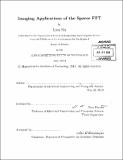| dc.contributor.advisor | Dina Katabi. | en_US |
| dc.contributor.author | Shi, Lixin, Ph. D. Massachusetts Institute of Technology | en_US |
| dc.contributor.other | Massachusetts Institute of Technology. Department of Electrical Engineering and Computer Science. | en_US |
| dc.date.accessioned | 2013-11-18T19:17:03Z | |
| dc.date.available | 2013-11-18T19:17:03Z | |
| dc.date.copyright | 2013 | en_US |
| dc.date.issued | 2013 | en_US |
| dc.identifier.uri | http://hdl.handle.net/1721.1/82388 | |
| dc.description | Thesis (S.M.)--Massachusetts Institute of Technology, Dept. of Electrical Engineering and Computer Science, 2013. | en_US |
| dc.description | Cataloged from PDF version of thesis. | en_US |
| dc.description | Includes bibliographical references (p. 77-81). | en_US |
| dc.description.abstract | The sparse Fourier transform leverages the intrinsic sparsity of the frequency spectrum in many natural applications to compute the discrete Fourier Transform (DFT) in sub-linear time. Consequently, it has the potential to enable Big Data applications. In this thesis, we focus on extending the sparse Fourier transform (sparse FFT) to two imaging applications: 4D Light Field and Magnetic Resonance Spectroscopy. Directly applying sparse FFT to these applications however will not work. We need to extend the sparse FFT algorithm to address the following challenges: First, both applications are sample-intensive. It is time consuming, costly, and difficult to acquire samples. So, we need a new sparse FFT algorithm that minimizes the number of required input samples instead of purely focusing on the running time. Second, for these applications the spectra are not very sparse in the discrete Fourier domain. The sparsity is much greater in the continuous Fourier domain. Hence, we need a new sparse FFT algorithm that can leverage the sparsity in the continuous domain as opposed to the discrete domain. In this thesis, we design a sparse FFT algorithm suitable for our imaging applications. Our algorithm contains two phases: it first reconstructs a coarse discrete spectrum and then refines it using gradient descent in the continuous Fourier domain. In our experiments, we showed high-quality reconstruction of 4D light field with only 10% 20% of the samples, and a reduction of the MRS acquisition time by a factor of 3x 4x. | en_US |
| dc.description.statementofresponsibility | by Lixin Shi. | en_US |
| dc.format.extent | 81 p. | en_US |
| dc.language.iso | eng | en_US |
| dc.publisher | Massachusetts Institute of Technology | en_US |
| dc.rights | M.I.T. theses are protected by
copyright. They may be viewed from this source for any purpose, but
reproduction or distribution in any format is prohibited without written
permission. See provided URL for inquiries about permission. | en_US |
| dc.rights.uri | http://dspace.mit.edu/handle/1721.1/7582 | en_US |
| dc.subject | Electrical Engineering and Computer Science. | en_US |
| dc.title | Imaging applications of the sparse FFT | en_US |
| dc.type | Thesis | en_US |
| dc.description.degree | S.M. | en_US |
| dc.contributor.department | Massachusetts Institute of Technology. Department of Electrical Engineering and Computer Science | |
| dc.identifier.oclc | 862076146 | en_US |
